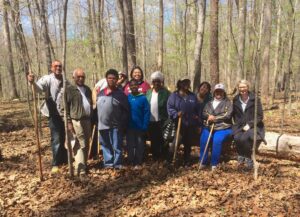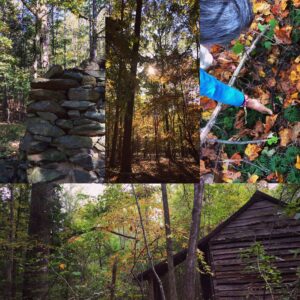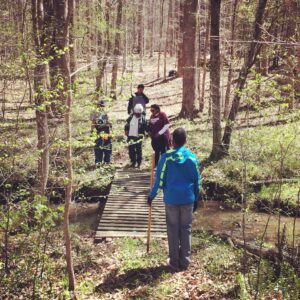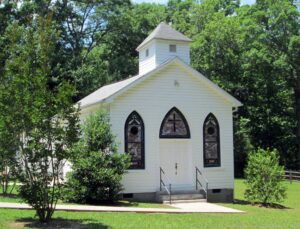Back Ways explored the rural South by following the paths southerners created to visit one another, to shop and trade, to reach homes and churches, and to avoid one another. The project began with a provocative premise: did white-run municipalities in the Jim Crow South deliberately neglect roads that led to and from important black institutions? And if so, did the eventual decline of those roads harm those communities?

Community work day at the historic Harvey’s Chapel AME Church site near Hillsborough, NC, April 2017
Answering this question required a new kind of oral history and archival research: seeking out records that might indicated neglect rather than aggression, maps that showed the appearance and disappearance of roads and other features, and oral narratives that delved deep into space and place.
Back Ways was a project of the Southern Oral History Program that worked to understand the social experience of racial segregation in the rural South through oral history and archival research. In 2016-17, SOHP field scholar and lifelong local resident Rachel Cotterman collaborated with members of the Harvey’s Chapel AME Church and other neighbors to trace the histories of rural back roads southwest of Hillsborough. This digital exhibit is a work-in-progress collection of what they learned together.
What These Woods Remember: A Community History Project with Harvey’s Chapel AME Church
This exhibit explores the social history of a network of wagon roads in Cheeks Township outside of Hillsborough, North Carolina. A thriving community of small farms at the turn of the 20th century, this area was home to two black churches and a one-room black school house. After Orange County transitioned to a modern system of state highway maintenance, many of the wagon roads in this area fell into a state of disrepair, leading to the eventual displacement of some residents and the return of once fertile farmland to forest. In the face of loss and change, however, many local families remain deeply connected to this land across generations.
 Outside of the small historic downtown of Hillsborough, North Carolina, the Piedmont hills stretch out beneath forest and farmland. Small creeks and rivers wind their way between banks and ridges. Summer water is shallow, lazy, and warm, but spring rains bring faster currents popping and curdling over gray-green stones. Animal and plant communities find quiet shelter across the landscape. Oak, tulip poplar, pine. Cardinal, gray squirrel, white deer.
Outside of the small historic downtown of Hillsborough, North Carolina, the Piedmont hills stretch out beneath forest and farmland. Small creeks and rivers wind their way between banks and ridges. Summer water is shallow, lazy, and warm, but spring rains bring faster currents popping and curdling over gray-green stones. Animal and plant communities find quiet shelter across the landscape. Oak, tulip poplar, pine. Cardinal, gray squirrel, white deer.

These hills hold human homes too, past and present. Some strike the eye – bright white siding, slanting porches, driveways full of cars. Gravel roads and clean wide asphalt. Others lend more subtle signal – a single chain gate across an overgrown path. Faint depressions in the soil. Collapsed chimney stones that bleed into the earth and back out again. Rusted metal and milky quartz.
The historic site of Harvey’s Chapel AME Church sits high up on a ridge, about 3 miles southwest of town, girded by creeks on three sides.

Youth and elders cross the bridge to visit the historic chapel site.
The church was founded in 1892 by a group of African-American families who had been meeting as a “brush arbor” worship community and then joined together to purchase land for a fixed location. After the road on which they were located fell into a state of disrepair in the 1930s, they moved locations twice–first to a local one-room schoolhouse and then building a new church nearby. The historic site has been largely swallowed by forest, but the foundation stones of the church and a sizable cemetery are still visible. It remains an important ancestral site for this community.

As of 2017, Harvey’s Chapel continues to gather in their third location, and most of the congregation members are descended from the original group of founding families.
But what happened to these wagon roads, and what was life like for the people who lived, worked, and worshiped along them?
Oral histories
In the oral histories we have collected, longtime residents paint a nuanced picture of these woods as home to overlapping experiences of community, displacement, discrimination, resilience and joy.
Clinton Thompson & Harold Russell recall traveling by wagon:
Willie Breeze on the persistence of racial segregation in Hillsborough:
Elaine Terrell on rural social life (and an ancestor with a flair for theatrics!):
Clinton Thompson on interracial cooperation among farmers:
Harold Russell on the difficulty of tracing black land deeds in the public record:
The full interviews are available here.